
- Index
- Artist
- Antonio Devity (4)
- Charles Levier (3)
- Henri Matisse (8)
- Illegible (5)
- Illegible Signature (58)
- Jean Daumier (3)
- Julius Polek (3)
- L. Sihiinzel (4)
- London (4)
- Maren (3)
- Max Ernst (6)
- Reinald Morgen (3)
- Remedios Varo (7)
- Salvador Dali (6)
- See Description (9)
- T.bailey (4)
- Unknown (109)
- Unsigned (7)
- Yu Liang Jin (4)
- Yu Yin Xin (4)
- Other (944)
- Framing
- Material
- Signed By
- Agapito Labios (2)
- Anton Gutknecht (2)
- Antonio Devity (2)
- Arthur Hierer (2)
- Artist (22)
- Augustus Spencer (2)
- Bailey (4)
- Charles Levier (2)
- Corot (4)
- E.w. Strack (2)
- Géo FranÇois (2)
- Illegible (8)
- Illegible Signature (53)
- J E Lemke (2)
- John Hughes (2)
- Louis Siegriest (2)
- Mario Cortiello (2)
- S. Vasiu? (2)
- Unknown (4)
- Wilson (2)
- Other (1075)
- Size
- Unit Of Sale
Historic Antique WWII Black African American Soldier Portrait Oil Painting 40
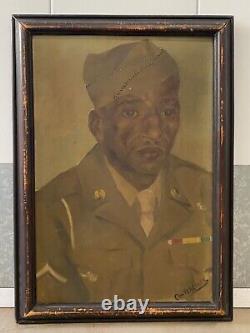
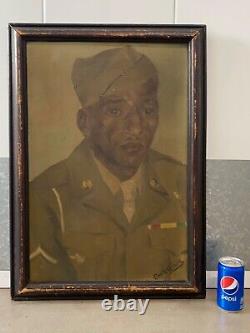
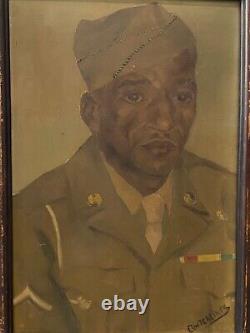
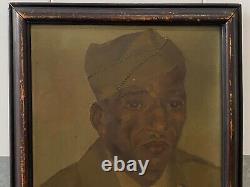
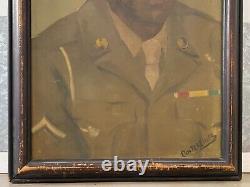

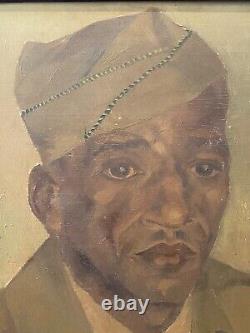
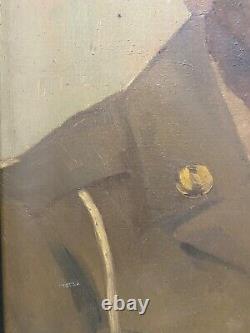

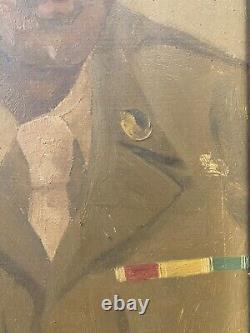



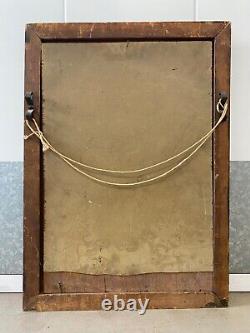


This is a culturally important and Historic Antique WWII Black African American Soldier Portrait Oil Painting on wood, depicting the portrait of an African American Army private during the Second World War. This painting displays the portrait of a stoic and brave soldier, who looks away from the gaze of the viewer, and reveals what is described by historians as a "1000-Yard-Stare" in the expression of his eyes. The patch on his right arm reveals that he was a Private in the United States Army, and he wears various ribbons on his chest.
This work is signed: "Oosterlinck" in the lower right corner. This surname almost wholly exists in Belgium and based on the unusual painting medium and artist's name, it can be surmised that this artwork was painted by a grateful Belgian artist after the Liberation of Belgium in 1944. African Americans played a significant role in this conflict, and the infamous "Massacre of the Wereth 11, " where 11 African American soldiers were executed by Nazis in Belgium, was recently commemorated by the Dutch with an elaborate memorial ceremony.
Approximately 18 x 25 inches including frame. Actual artwork is approximately 14 3/4 x 21 3/4 inches.
Good condition for age and storage, with moderate scuffing and edge wear to the original period frame please see photos. This historic work of art is Priced to Sell. Acquired from an old collection in Los Angeles County, California. If you like what you see, I encourage you to make an Offer. Please check out my other listings for more wonderful and unique artworks! About African American Soldiers in WWII, and the Liberation of Belgium. The black liberators who helped defeat the Nazis and free the Dutch get their due. The Embassy of the Netherlands marks the 75th anniversary of liberation by honoring the black soldiers who risked their lives to end German occupation. He's 95 now, and many of his Army comrades are gone. Baldwin one of the last living black liberators, the African American soldiers who rolled into Holland in 1945 to fight the Nazis and helped free the Dutch from German occupation. Baldwin still remembers that push in the final months of World War II.He fired an 81mm mortar gun at Nazi troops, who had a stranglehold on Holland during the war. Thousands of Dutch Jews had been rounded up and sent to concentration camps. The country had been ravaged by the horrors of genocide, hunger and starvation. "We took 23 cities in three days, " recalled Baldwin, who fought with the U. Army's all-black 784th Tank Battalion.
We were taking the cities, meaning killing Germans, and running them out. We came in and freed them. To know I had a role in the liberation of Holland means a lot. Last week in Washington, the Embassy of the Netherlands honored Baldwin and hundreds of other black soldiers as part of its commemoration of the 75th anniversary of liberation."The citizens of the Kingdom of the Netherlands express their sincere appreciation and gratitude for your sacrifice, courage, and willingness to fight for freedom while enduring the hardships of war, " the embassy wrote in a certificate of appreciation presented to Baldwin.. Seventy-five years later, the footprints of courageous men like you are still found in our thriving economy, our stable government, and in our hearts and minds.
Freedom sways in the wind while our flag flutters in peace. The liberation of Holland, which had been invaded by the Nazis in 1940, began after thousands of Allied troops landed at Normandy on June 6, 1944.
The Allied forces drove German troops from France and Belgium. By September 1944, the Allies arrived in the Netherlands. When the fighting ended, Europe broke free of Nazi occupation, and thousands and thousands of soldiers had died, including Americans - 8,291 buried in the.
Said Commodore Paul Herber, the embassy's defense attache. In many ways, the cemetery is to the Netherlands what Arlington National Cemetery is to the United States. One cannot walk through Margraten without feeling the sacrifices American soldiers made to free Europe and the Netherlands. Dutch families have adopted each grave at Netherlands American Cemetery in Margraten, making sure it is tended. Every year, these families lay flowers on the graves."They pay respect and honor soldiers' sacrifices, " Herber said. Many Dutch families have connected with the soldiers' families.
They've developed bonds and forged friendships across the Atlantic Ocean. But, Herber said, the Dutch who adopted the graves of the 172 African American soldiers buried in Margraten have had some difficulty finding family members still living in the United States.Because of missing records, African American soldiers, who fought in segregated units, were often unjustly overlooked by history. In 2009, the Netherlands began trying to correct that oversight. Historians in the Netherlands and in the United States began work on a black liberators project by trying to find descendants and relatives of the 172 who gave their lives to defeat the Nazis. "We are determined to find each and every one of the families, " said Ric Murphy, national vice president for history of the Afro-American Historical and Genealogical Society.
When you think about these men who went into World War II, came from the segregated South, predominantly, many of them went into battle so they could be treated like men, and come out with certain dignities. They went to a foreign land to fight a foreign war to liberate foreign people. And many of them who survived came back to a segregated South, to an environment where they, themselves, were not treated as free men. But, Murphy said, some of the men who came home never talked about the war, never shared stories with their families.
Hannah Scruggs, genealogy reference assistant at the Robert F. Smith Explore Your Family History Center of the National Museum of African American History and Culture, encouraged relatives of World War II veterans to begin collecting oral histories. "Ask questions of your family members who are getting older, " Scruggs said. I encourage family members who don't want to talk, who have seen truly horrific things, please write it down. Researchers working on the black liberators project have found families of 24 black soldiers, including LaVonne Taliaferro-Bunch, whose great-uncle Lynwood Taliaferro was killed in the Netherlands in March 31, 1945. "His body rests in the Netherlands at the Margraten cemetery, " Herber said. For many, this is an unknown story - not only here but in the Netherlands. We want everyone to know the Netherlands have not forgotten the efforts of these heroes. We will continue these efforts and find the descendants of those who paid the ultimate sacrifice for our liberation.In 2015, Baldwin received a letter from G. Baldwin's battalion had liberated the town of Venlo on March 1, 1945.
"My mother, who was 9, was looking out a window and saw the first Afro-American soldiers slowly coming down the street, close to the houses, " Beusker wrote. At the time she had already been hiding for weeks, with the rest of her family in the house of an aunt. Beusker remembers the British shelling the German troops on the "Venlo side" of the River Meuse.
"The bridge and the Luftwaffe base east of the town were bombed repeatedly in 1944 by the Allies, " Beusker wrote. Eventually, the Germans blew up the bridge in November 1944. Those bombing have claimed many civilian casualties, but never have I heard grievances by the generation that experienced the war against the allies. Massacred Wereth 11 Honored at Belgian Ceremony.
These men are now remembered as The Wereth 11. To pay tribute to these men, Color Guard members from Lanstuhl Regional Medical Center, Germany, joined a contingent of fellow U. And Belgian Servicemembers, the Vogelweh Gospel Service Choir, and 350 other local and well-traveled attendees at the May 17, 2014, ceremony. The honored Soldiers were attached to the 333rd Field Artillery Battalion, an all-black unit, at the onset of the Battle of the Bulge.
On December 17, 1944, they were separated from their unit and found themselves trudging through deep snow in the woods of eastern Belgium in an attempt to avoid German patrols. After walking for hours, the hungry and weary Soldiers arrived in the town of Wereth where the men were taken in by local farmer Mathias Langer.
They were given hot coffee, bread and an opportunity to rest. The Langer family did not hesitate to extend a helping hand, knowing full well they could be persecuted for doing so. Soon after, while the men were still eating, German SS arrived at the Langer house (most likely being tipped off by a Nazi sympathizer with the Soldiers' location). Assuming the men did not want to cause any more trouble for the Langer family, they emerged from the house, hands raised in the air. The 11 men were taken prisoner by the SS and forced to run in front of their vehicle to a trail about 70 meters from the house.
As the Langer family watched them disappear into the night, it would be the last time they would see them alive. In early February after the fighting had subsided and it was safe to leave their home, the Langer family proceeded on their usual route to church when they discovered the Soldiers' bodies. William Everett who examined the bodies, most of the men had been killed by blows to the head (most likely with a rifle stock), repeatedly stabbed with bayonets and shot multiple times. 11, 1994, about 50 years after the massacre, Hermann Langer, son of Mathias, erected a monument to commemorate the Soldiers he remembered as a child.
Throughout his lifetime, he could not forget the desperation he saw in the eyes of the American Soldiers at his home, or the dignity he witnessed when they faced the SS. Nor could he forget the generosity of his father. He constructed a cross from the pieces of his own family's gravestones in order to ensure permanent structure to coincide with the lasting memory of the brave Soldiers.
Not only did Hermann create a monument that will forever pay tribute to these men, but he built it in exact area where the men were murdered. This field also stands as the location for the yearly ceremony to remember and honor the Soldiers. This year's ceremony was notable because it marked the 20th anniversary honoring the Wereth 11, as well as the dedication of a beech tree in celebration of Hermann Langer, as this is the first ceremony to occur since his death. In this area of Belgium, there is an old tradition that is carried on in order to commemorate particular events such as the birth of a child, a remarkable anniversary, or to remember a loved one, and that is done through the planting of a tree.Each year the memorial ceremony welcomes a guest speaker to deliver a message on behalf of the Soldiers. Mitchell Kilgo, who delivered this year's address a few days before relinquishing command of 5th Signal Command, spoke about his connection and passion towards the Soldiers and the memorial dedicated in honor of the Wereth 11 and all other African-American Soldiers. African Americans in World War II. Fighting for a Double Victory. African Americans served bravely and with distinction in every theater of World War II, while simultaneously struggling for their own civil rights from the world's greatest democracy.
Although the United States Armed Forces were officially segregated until 1948, WWII laid the foundation for post-war integration of the military. In 1941 fewer than 4,000 African Americans were serving in the military and only twelve African Americans had become officers. By 1945, more than 1.2 million African Americans would be serving in uniform on the Home Front, in Europe, and the Pacific (including thousands of African American women in the Women's auxiliaries).
During the war years, the segregation practices of civilian life spilled over into the military. The draft was segregated and more often than not African Americans were passed over by the all-white draft boards. Pressure from the NAACP led President Roosevelt to pledge that African Americans would be enlisted according to their percentage in the population. Although this percentage, 10.6%, was never actually attained in the services during the war, African American numbers grew dramatically in the Army, Navy, Army Air Force, Marine Corps, and the Coast Guard. Many drove for the famous "Red Ball Express, " which carried a half million tons of supplies to the advancing First and Third Armies through France. By 1945, however, troop losses virtually forced the military to begin placing more African American troops into positions as infantrymen, pilots, tankers, medics, and officers in increasing numbers.In all positions and ranks, they served with as much honor, distinction, and courage as any American soldier did. Still, African American MPs stationed in the South often could not enter restaurants where their German prisoners were being served a meal. On D-Day, the First Army on Omaha and Utah Beaches included about 1,700 African American troops.
This number included a section of the 327th Quartermaster Service Company and the 320th Anti-Aircraft Barrage Balloon Battalion, which protected troops on the beach from aerial attack. Soon the all-black 761st Tank Battalion was fighting its way through France with Patton's Third Army.
They spent 183 days in combat and were credited with capturing 30 major towns in France, Belgium, and Germany. The Army Air Force also established several African American fighter and bomber groups. The famous "Tuskegee Airmen" of the 332nd Fighter Group became part of the 15th Air Force, flying ground support missions over Anzio and escorting bombers on missions over Southern Italy. The Tuskegee Airmen flew more than 15,000 sorties May 1943 and June 1945. Bomber crews often requested to be escorted by these "Redtails, " a nicknamed acquired from the painted tails of Tuskegee fighter planes.
Sixty-six Tuskegee Airmen died in combat. Stephen Ambrose identified the lamentable American irony of WWII, writing, "The world's greatest democracy fought the world's greatest racist with a segregated army" (Ambrose, Citizen Soldier). During the global conflict, African American leaders and organizations established the "Double V" campaign, calling for victory against the enemy overseas and victory against racism at home. This new black consciousness and the defiant rejection of unjustifiable racism planted important seeds for the post-War civil rights movement. The National WWII Museum honors the contributions of African Americans in World War II.
African Americans Fought for Freedom at Home and Abroad during World War II. In the face of racism and segregation, Black men and women served in every branch of the armed services during World War II. More than one million African American men and women served in every branch of the US armed forces during World War II.
In addition to battling the forces of Fascism abroad, these Americans also battled racism in the United States and in the US military. The Army, Navy, and Marine Corps all segregated African Americans into separate units because of the belief that they were not as capable as white service members.Adding to this indignity, the Army frequently assigned White officers from the American South to command Black infantrymen. In spite of these dispiriting obstacles, African Americans fought with distinction in every theater of the war. Some of the more famous Black units included the 332nd Fighter Group, which shot down 112 enemy planes during the course of 179 bomber escort missions over Europe, and the 761st Tank Battalion, which served in General George S.
Paul, of the 26th Division, singled out the 761st for special praise after its first action in France by writing, I consider the 761st Tank Battalion to have entered combat with such conspicuous courage and success as to warrant special commendation. African Americans also served in equally vital positions throughout the Army as nurses, engineers, truck drivers, gunners, and paratroopers. Lesser-known units include the African American 92nd and 93rd Infantry Divisions, which fought in the European and the Pacific theaters respectively.The 25th Infantry Regiment of the 93rd Division took part in the Bougainville campaign in April and May of 1944. This willingness on the part of African American soldiers to sacrifice their lives for a country that treated them as second-class citizens is remarkable. Various accounts relate how German prisoners of war could enter facilities reserved for white Americans that black servicemen could not patronize. When the US Marine Corps began recruiting a contingent of black Marines in June 1942, men from across the country flocked to enlist. These Marines trained at Montford Point, North Carolina.
Although the "Montford Point Marines" excelled at gunnery and drill, they too faced the same segregation and hostility as men and women in the other branches. The Marine Corps Commandant, Major General Thomas Holcomb, resented being forced to accept African Americans into the Corps, and unlike the Army, the Marine Corps did not permit any Black men to become officers until November 1945. In May 1943, Private R. Wood was even arrested for impersonating a Marine when he traveled home on leave to Cleveland, Ohio.
The police officers did not know African American Marines existed. In North Carolina, a policeman slapped Edgar Cole's official orders out of his hand and told Cole that he was not allowed to wait on the street corner for a Marine driver to pick him up and take him to Montford Point. Despite the racism black Marines encountered, they distinguished themselves in the battles of Peleliu, Saipan, Iwo Jima, and Okinawa.
By 1944, more than 18,000 Marines had trained at Montford Point and 12,000 were stationed overseas. Even when African Americans were denied the opportunity to serve in combat roles, they still found ways to distinguish themselves.
Doris "Dorie" Miller was a steward aboard the USS. During the Japanese attack on Pearl Harbor on December 7, 1941. For his actions, Miller became the first African American to receive the Navy Cross.Following Dorie's actions and lobbying from civil rights groups, the US Navy increasingly sent Black sailors to sea in combat roles. On March 20, 1944, the Navy commissioned the destroyer escort.
Other African Americans serving in Construction Battalions behind the lines volunteered for extremely hazardous duty as stretcher bearers in several Pacific campaigns. The achievements of African Americans during the war provided valuable evidence that civil rights activists used in their demands for equality. Truman ordered the US military to desegregate entirely in 1948, African Americans' fight for equal civil rights was far from over. This item is in the category "Art\Paintings". The seller is "willsusa_utzeqm" and is located in this country: US. This item can be shipped to United States.- Artist: Oosterlinck
- Signed By: Oosterlinck
- Size: Large
- Signed: Yes
- Period: Post-War (1940-1970)
- Material: Oil, Wood
- Region of Origin: California, USA
- Framing: Framed
- Subject: Men, World War II (1939-1945)
- Type: Painting
- Original/Licensed Reproduction: Original
- Item Height: 25 in
- Style: Portraiture, Realism, WPA
- Theme: Americana, Conflicts & Wars
- Features: One of a Kind (OOAK)
- Production Technique: Oil Painting
- Country/Region of Manufacture: United States
- Handmade: Yes
- Item Width: 18 in
- Time Period Produced: 1925-1949

